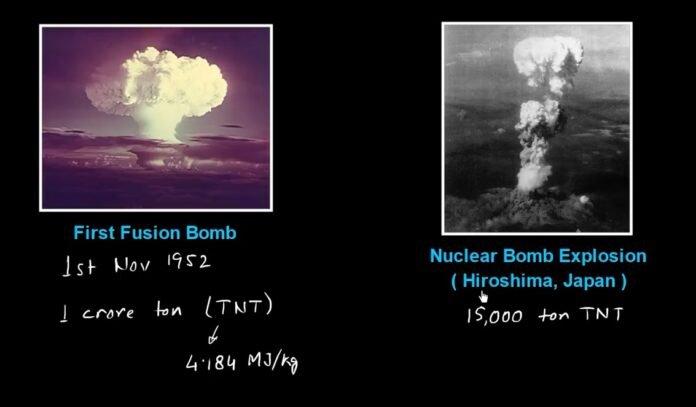The purpose of this article is to understand controlled thermonuclear fusion. You will also find much other important information that you need to know. For a better understanding of controlled thermonuclear fusion, it is essential to discuss what is nuclear fusion.
Introduction
When two or more atomic nuclei combine to form new atomic and subatomic particles, the reaction is known as nuclear fusion. This reaction releases enormous quantities of energy as two light atomic nuclei combine to produce a single heavier one. This reaction drives all other stars, including the sun. Nuclei must clash with one another at temperatures as high as ten million degrees Celsius in order to fuse in our sun. Compared to fission, fusion might provide four times more energy per kilogram of fuel. Although a lot of energy is produced by this reaction, such reactions are uncontrollable. We can achieve what is known as controlled thermonuclear fusion if we can provide the conditions necessary for such a reaction to occur while controlling its rate. Since the 1930s, scientists have been working to establish controlled fusion inside fusion reactors, but the technology is still in the early stages of development.
Nuclear fusion reaction
The deuterium-tritium (DT) fusion process is of particular interest to scientists working on fusion energy applications. The ITER international fusion energy project will mark science’s initial attempt to sustain a fusion reaction over extended periods of time. The fusion processes taking place within the plasma itself will heat the “burning plasmas” in ITER.

Fig – 1
A neutron and helium nucleus is produced through DT fusion. Moreover, compared to other fusion processes, it releases a lot more energy during the process. Because DT reactions generate a lot of energy and take place at lower temperatures than those of other elements, they are of particular interest to researchers.
What is the thermonuclear reaction?
The term “thermonuclear reaction” refers to a nuclear reaction that occurs at extremely high temperatures. The electric force of repulsion between the positively charged nuclei is the greatest obstacle to nuclear fusion. Fusion is feasible when each nucleus has enough kinetic energy to overcome the attraction caused by having a similar charge. Fusion reaction required a very high temperature. Thus due to the high-temperature nuclear repulsion is able to be overcome. Thus it is called a thermonuclear reaction.
Example
Lets’s take an example of hydrogen isotopes. Here two hydrogen isotopes which are called protium combined and formed another isotope called deuterium.
Here, refers to the positron and neutrino. In this reaction 0.42 MeV energy was emitted.
The controlled thermonuclear fusion reaction
Generally, thermonuclear reactions are difficult to control due to the high temperature and kinetic energy of the nuclei. The energy emitted from the thermonuclear reaction could be put to good use if it could be managed to proceed more slowly.
To control the fusion reaction it can have the following problems:
• Very high temperature is required to proceed with the fusion of nuclei.
• It is needed to find out a container that can stand at this high temperature (around 10^7 K).
• Due to the high temperature the gas gets ionized which is called plasma.
• It is also challenging to make a container for this high-temperature plasma.
• One of the solutions to this problem is provided by some researchers that plasma can be trapped in the presence of the magnetic field.
• Because the nuclei of hydrogen and its isotopes carry smaller amounts of charge and hence have smaller repulsive forces, they are more suited for controlled thermonuclear reactions.
Procedure and reaction controlled thermonuclear fusion:
The controlled thermonuclear fusion reaction can be achieved in the lab by the following process.
Deuteron-Deuteron reaction (d-d reaction)
Combination of a proton and a neutron is called a deuteron. It is an isotope of hydrogen. The energy required to combine two deuterons is around 35 keV. Which can be generated in the laboratory.
Or
Deuteron-Tretone reaction (d-t reaction)
Tretone is the nucleus of tritium. Tritium is an isotope of hydrogen. It is the combination of a proton and two neutrons.
The goal of controlled fusion is to contain a high-temperature plasma of deuterium and tritium using magnetic fields. Using a tokamak, a doughnut-shaped vessel with a powerful, helical magnetic field that directs the charged particles around it, is one approach to achieve this. Similar to how the Sun generates energy, the nuclei in the plasma go through fusion processes that turn some of their rest mass into energy.

Fig: Fusion reactin plant
Recommended Articles:
Conservative Force: Properties, Examples, And Non-Conservative
Constants in Physics: Fundamental, Electromagnetic, Quantum, And Cosmological
Read All About Constellations And Its Types
Charging by Induction: Introduction, Derivation, Examples, And Applications
Continuous Charge Distribution: Density, Type, Importance, And Comparison
There are two different kinds of energy-releasing reactions: nuclear fusion and nuclear fission. The primary difference between both of these processes is that fusion involves joining two or more small atoms together, whereas fission involves dividing an atom into two or more small ones. The nuclear fission reaction occurs in nuclear reactors. In nuclear reactors nuclei with heavy atoms can split into several fragments created by nuclei with lighter atoms when hit with neutrons, resulting in neutron emission and a significant release of energy. In nuclear reactors to continue the chain reaction, the moderator slows down the neutrons created by fission. The reaction rate can then be changed by adding control rods to the reactor core or removing them to speed up the process. Nuclear fusion reaction can be observed in the lighting of the Sun and stars. In nuclear weapons, the nuclear fusion reaction plays an important role. Whereas, electricity generation by fusion is still under research. Controlled Thermonuclear Fusion FAQs
What is the difference between nuclear fission and nuclear fusion?
What type of reaction occurred in the nuclear reactor?
How reactions are controlled in nuclear reactors?
Give some examples of where nuclear fusion generates energy.
